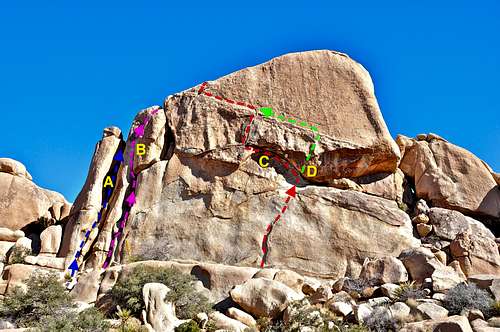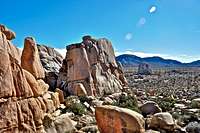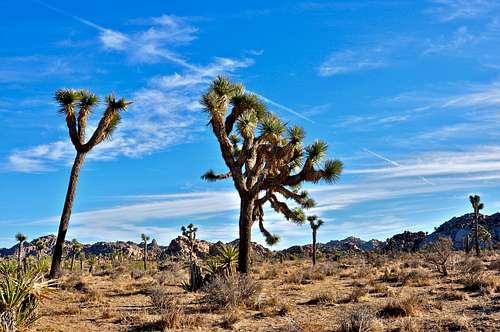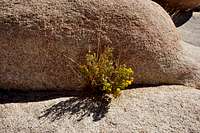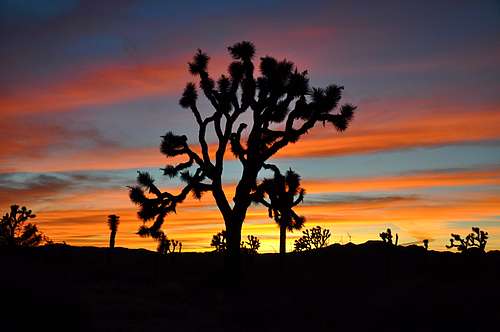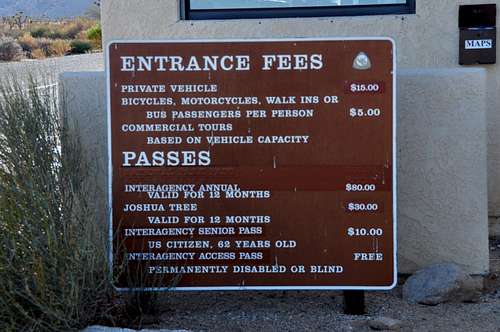-
 3518 Hits
3518 Hits
-
 85.87% Score
85.87% Score
-
 21 Votes
21 Votes
|
|
Mountain/Rock |
|---|---|
|
|
34.01858°N / 116.16614°W |
|
|
Riverside |
|
|
Trad Climbing |
|
|
Spring, Summer, Fall |
|
|
4200 ft / 1280 m |
|
|
Overview
Sidewinder Rock is a rock formation in the Steve Canyon area of Joshua Tree National Park, California.
This distinct formation guards the north flank short and steep Steve Canyon. It sits across from Orc Wall and dominates the entire Steve Canyon area. The name of this formation is drawn from a route by this name and the most prominent feature on this rock. This feature is a right to left, gently rising, dike on the upper portion of this rock clearly visible from Park Boulevard, the main artery through Joshua Tree National Park.
Another prominent feature of Sidewinder Rock is a pillar, partially separated from the main formation, on the north side of the rock. This pillar is called King Pin, and if you can climb a totally unprotected chimney it makes with the main formation, you can rappel from a set of anchor bolts on its to.
Select Routes
Being within a minute walking distance from the Park Boulevard and a few hundred yards from Hidden Valley Campground, Sidewinder Rock was noticed and climbed as early as 1972. The young and talented John Long established one of the hardest routes on this rock, and in fact in all of Joshua Tree at that time. This route, which is still one of the most sought after routes for the up and coming climber, is called Jumping Jack Crack, rated 11a.
It was not until 1974 that the most famous route, Sidewinder, on this rock was established. At that time, the first ascent party rated the difficulty at 5.9+. Through the years the route got plenty of traffic and the rating was increased to 10b. The thin face above the initial flake became the crux of the route and deserved a 10b difficulty rating. In the more recent years and decades some variations to the start of Sidewinder have been done. These variations are much more difficult and and don't see as much traffic as the original start.
In contrast to the west face, the east face of Sidewinder Rock is not nearly as distinct and popular. The east face, very rarely visited, is comprised of columns separated by wide cracks and stacked boulders on its north end. The large stacked boulders of the north end make for a convoluted and not so easy route for descent.
List of the select routes
Select Routes of Sidewinder Rock | |
| A | Skinny Pin, 5.4, Totally unprotected chimney, anchor |
| B | Jumping Jack Crack, 11a, Standard Rack, pro to 3.5 inches |
| C | Sidewinder, 10b, 2 bolts, standard rack |
| D | Diamond Back, 10d, Bolts and pro to 2.5" |
| E | Jack Grit, 10a, Standard Rack |
| F | Land of The Long White Cloud, 10b, standard rack |
| G | 5th class descent ledges |
How to Get There
from the west entrance to Joshua Tree National Park, drive 8.3 miles on Park Boulevard to a turnout about quarter of a mile before reaching Intersection Rock parking lot. Looking on the opposite side of the road, in the northeasterly direction, you will see Watanobe Wall to the west of the narrow and steep Steve Canyon. Park in the turnout and and head for Steve Canyon. Sidewinder Rock is the very first formation to your right as you enter Steve Canyon.
Camping, Noise Considerations, Environmental Concerns, Fees & Food
Please tread lightly. The Access Fund has gone to great lengths posting trail marker for approaches to many of the more popular crags. Do your best to stay on these trails, and where you are forced to use a different path, choose the ones that rain can mend in time. Drainages make for good trails where there are no established trails.
Avoid stepping on native and fragile plants, and do not feed the coyotes. Coyotes are very much used to people and often hang around picnic areas and camp grounds in hopes of getting a hand out. It’s better to let them live their natural life.
Camping
There are nine campgrounds in Joshua Tree National Park. At the entrance to the park you are always asked if you would care to have a map and a brochure. The brochure will have plenty of information on the campgrounds and the map will guide you to many of the pleasant hikes throughout the park. You may even get the latest information as to availability of campsites. During the peak season (mid winter through spring) finding a campsite may become a major task. It is highly recommended to use the following link to get more information in advance.
Joshua Tree Camping
Noise considerations
When you are camping with friends and sitting around the fire, it is easy to forget that there are other people trying to sleep in the nearby campsites. It is important to put yourself in their shoes. Keep the noise and music to a minimum and certainly not too much past 10 p.m. Your neighbors will smile at you in the morning instead of giving you dirty looks.
Fees and Food
My wife and I have had Thai food in many different restaurants and cities. This Thai place beats them all. In November when the number of visitors to Joshua Tree reaches its peak, this restaurant puts on a Thai buffet, all you can eat for 10.95$/person. But, you must get there early, or be prepared to wait by the door for a table. The latest information indicates that the buffet style will be terminated by the end of February and will resume in November of 2010 for Friday and Saturday nights only..




